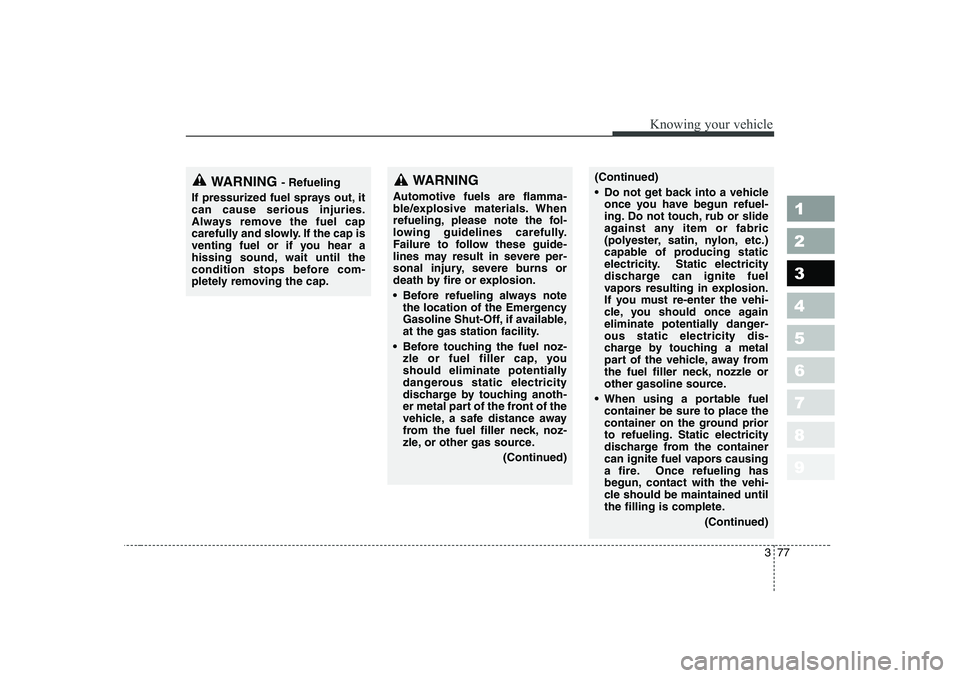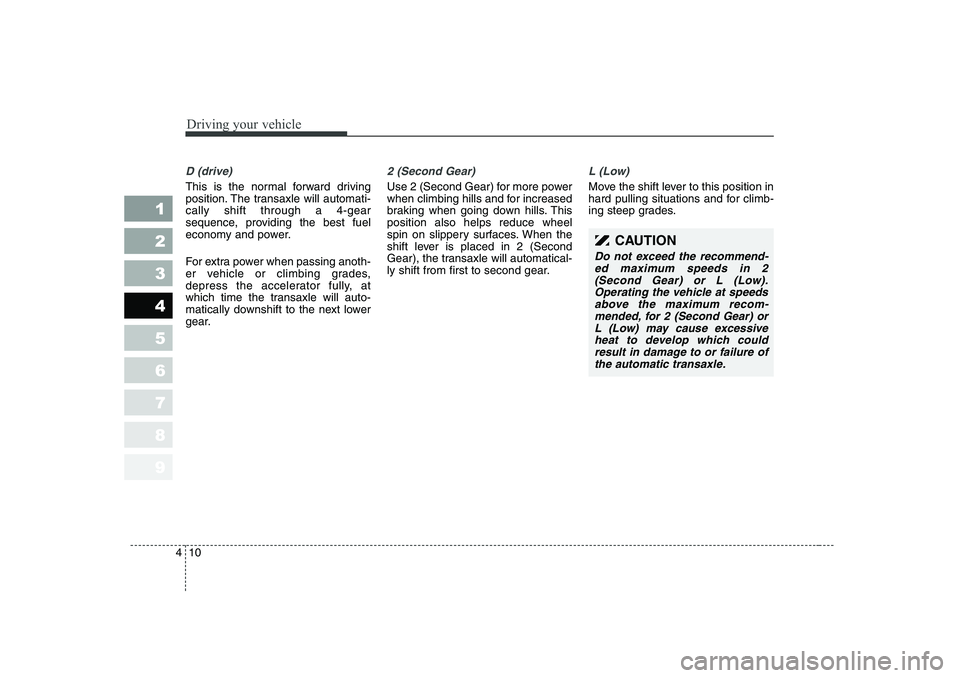Page 8 of 281
Your vehicle at a glance
2
2
1 23456789
INTERIOR OVERVIEW
1. Door lock/unlock lever .......................3- 9
2. Outside rearview mirror control
switch* ...............................................3-81
3. Power window switches* ...................3-13
4. Master power window control lock*...3-14
5. Vent controls .....................................4-46
6. Instrument cluster .............................4-23
7. Steering wheel ..................................4-20
8. Steering wheel tilt* ............................4-21
9. Hood release lever ...........................3-75
10. Fuel filler lid release lever ...............3-76
* : if equipped
1SAE0004/1SAA0005/1SAA0006
Page 11 of 281
1 23456789Keys / 3-2 Remote keyless entry / 3-4
Immobilizer system / 3-7
Door locks / 3-8
Window / 3-13 Seat / 3-16Safety belts / 3-32
Airbags-supplemental restraint system / 3-56Hood / 3-75
Fuel filler lid / 3-76
Mirrors / 3-79
Interior lights / 3-82
Storage compartment / 3-83
Interior features / 3-86Luggage net / 3-90Antenna / 3-91
Knowing your vehicle
Page 86 of 281

Knowing your vehicle
76
3
1 23456789
CAUTION
To avoid injury from sharp
objects, it is recommended thatprotective gloves be worn whenopening the fuel filler door man- ually.
Closing the hood
1. Before closing the hood, check the following:
All filler caps in engine compart- ment must be correctly installed.
Gloves, rags or any other com- bustible material must be
removed from the engine com-
partment.
2. Secure the support rod in its clip.
3. Lower the hood to about 30 cm (12 inches) height and then let it
drop to properly lock in place.
Make sure the hood is properly
locked before driving. 1. Stop the engine.
2. To open the fuel filler lid, pull the
release lever. 3. Pull the fuel filler lid out to open.
4. To remove the cap, turn the fuel
tank cap counter-clockwise.
5. Refuel as needed.
6. To install the cap, turn it clockwise until it “clicks”. This indicates that the cap is securely tightened.
7. Close the fuel filler lid and push it lightly and make sure that it issecurely closed.
CAUTION
Before closing the hood, make
sure that all engine parts andtools have been removed fromthe engine area and that noone’s hands are near the hoodopening.
Do not leave gloves, rags or any other combustible materi-al in the engine compartment.Doing so may cause a heat- induced fire.
FUEL FILLER LID
1SAA20181SAA2019
Page 87 of 281

377
1 23456789
Knowing your vehicle
WARNING - Refueling
If pressurized fuel sprays out, it can cause serious injuries.
Always remove the fuel cap
carefully and slowly. If the cap is
venting fuel or if you hear a
hissing sound, wait until the
condition stops before com-
pletely removing the cap.WARNING
Automotive fuels are flamma-
ble/explosive materials. When
refueling, please note the fol-
lowing guidelines carefully.
Failure to follow these guide-
lines may result in severe per-
sonal injury, severe burns or
death by fire or explosion.
Before refueling always note the location of the Emergency
Gasoline Shut-Off, if available,
at the gas station facility.
Before touching the fuel noz- zle or fuel filler cap, you
should eliminate potentially
dangerous static electricity
discharge by touching anoth-
er metal part of the front of the
vehicle, a safe distance away
from the fuel filler neck, noz-
zle, or other gas source.
(Continued)(Continued)
Do not get back into a vehicleonce you have begun refuel-
ing. Do not touch, rub or slide
against any item or fabric
(polyester, satin, nylon, etc.)
capable of producing static
electricity. Static electricity
discharge can ignite fuel
vapors resulting in explosion.
If you must re-enter the vehi-
cle, you should once again
eliminate potentially danger-ous static electricity dis-
charge by touching a metal
part of the vehicle, away from
the fuel filler neck, nozzle or
other gasoline source.
When using a portable fuel container be sure to place the
container on the ground prior
to refueling. Static electricity
discharge from the container
can ignite fuel vapors causing
a fire. Once refueling has
begun, contact with the vehi-
cle should be maintained until
the filling is complete.
(Continued)
Page 111 of 281

Driving your vehicle
10
4
1 23456789
CAUTION
Do not exceed the recommend-
ed maximum speeds in 2(Second Gear) or L (Low).Operating the vehicle at speeds above the maximum recom-mended, for 2 (Second Gear) orL (Low) may cause excessiveheat to develop which could result in damage to or failure ofthe automatic transaxle.
D (drive)
This is the normal forward driving
position. The transaxle will automati-cally shift through a 4-gear
sequence, providing the best fuel
economy and power.
For extra power when passing anoth-
er vehicle or climbing grades,
depress the accelerator fully, at
which time the transaxle will auto-
matically downshift to the next lower
gear.
2 (Second Gear)
Use 2 (Second Gear) for more power
when climbing hills and for increased
braking when going down hills. Thisposition also helps reduce wheel
spin on slippery surfaces. When the
shift lever is placed in 2 (Second
Gear), the transaxle will automatical-
ly shift from first to second gear.
L (Low)
Move the shift lever to this position in
hard pulling situations and for climb-
ing steep grades.
Page 124 of 281
423
1 23456789
Driving your vehicle
INSTRUMENT CLUSTER
1. Tachometer (if equipped)
2. Turn signal indicators
3. Speedometer4. Engine temperature indicator
5. Warning and indicator lights
6. Odometer / Tripmeter7. Tripmeter mode/reset button
8. Fuel gauge
5SAA2090/5SAB2090/5SAC2090/5SAD2090
■■Gasoline (Type A)
■
■ Gasoline (Type B) ■
■
Gasoline (Type C)
■
■ Gasoline (Type D)
➀
➁➁
➂
➃
➄➅
➇
➆
➀
➁➁
➂
➃
➄➅
➇
➆
➁➁
➂➃
➄➄➄➄➄
➅
➇
➆
➁➁
➂➃
➄➄➄➄➄
➅
➇
➆
Page 125 of 281
Driving your vehicle
24
4
1 23456789
1. Tachometer (if equipped)
2. Turn signal indicators
3. Speedometer 4. Engine temperature indicator
5. Warning and indicator lights
6. Odometer / Tripmeter7. Tripmeter mode/reset button
8. Fuel gauge
5SAA2090A/5SAB2090A/5SAC2090C/5SAD2090A
■■ Diesel (Type A)
■
■ Diesel (Type B) ■
■
Diesel (Type C)
■
■ Diesel (Type D)
➀
➁➁
➂
➃
➄➅
➇
➆
➀
➁➁
➂
➃
➄➅
➇
➆
➁➁
➂➃
➄➄
➅
➇
➆
➁➁
➂➃
➄➄➄➄➄
➄➄➄
➅
➇
➆
Page 126 of 281

425
1 23456789
Driving your vehicle
Speedometer
The speedometer indicates the for-
ward speed of the vehicle.
Odometer/Tripmeter
You can choose the odometer, trip-
meter A and tripmeter B by pressing
the tripmeter mode button.
Odometer
The odometer indicates the total dis-
tance the vehicle has been driven.
Tripmeter
TRIP A: Tripmeter A
TRIP B: Tripmeter B
The tripmeter indicates the distance
of individual trips selected by the
driver. Tripmeter A and B can be
reset to 0 by pressing the reset but-
ton for 1 second or more, and thenreleasing.Tachometer (if equipped) The tachometer indicates the
approximate number of engine revo-
lutions per minute (rpm). Use the tachometer to select the cor-
rect shift points and to prevent lug-
ging and/or over-revving the engine.
The tachometer pointer may move
slightly when the ignition switch is in
ACC or ON position with the engine
OFF. This movement is normal and
will not affect the accuracy of the
tachometer once the engine is run-ning.
✽✽
NOTICE
Do not operate the engine within the tachometer's RED ZONE.
This may cause severe engine dam-age.
Fuel gauge
The fuel gauge indicates the approx- imate amount of fuel remaining in thefuel tank.
Fuel tank capacity - 35 liters.
The fuel gauge is supplemented by a
low fuel warning light, which will illu-
minate when the fuel level has
dropped to about 6 liters.
GAUGES
1SAE2090